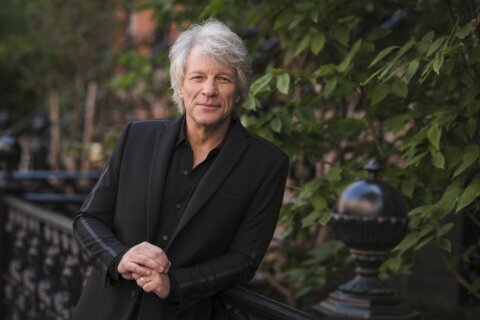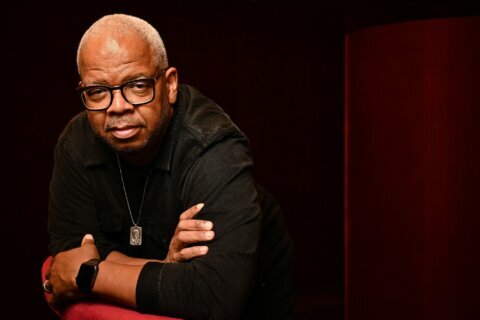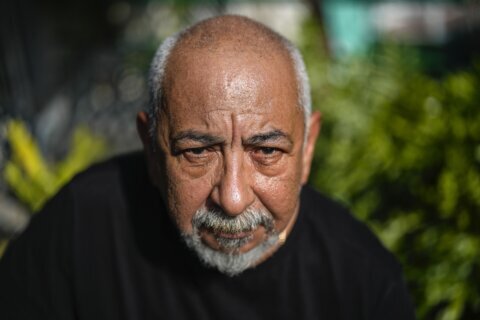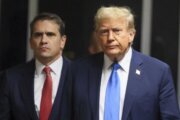WASHINGTON — Untouchable. In the gangster world, it means you’re a made man who can’t be whacked. In the film world, it means you’ll live on forever in our cultural imagination.
A quarter century later, “GoodFellas” (1990) remains as untouchable as ever, as director Martin Scorsese reunites with his cast Saturday at the Tribeca Film Festival for the film’s 25th anniversary. A re-mastered version will screen at New York’s Beacon Theatre, followed by a Q&A with Scorsese, Robert De Niro, Ray Liotta, Joe Pesci, Lorraine Bracco and Paul Sorvino, hosted by Jon Stewart.
“I was most proud of this film 25 years ago and equally proud of it now,” DeNiro said in a statement, while the late Roger Ebert dubbed it “the best mob movie ever.”
So what exactly makes this one for the ages? Here’s an in-depth look at Marty’s masterpiece:
![]()
Introduction
Throughout the arc of movie history, a certain few filmmakers step in with their own voice, telling personal tales from the streets of their own neighborhoods, and enrich the rest of our culture in the process. Martin Scorsese’s flickering film projector is a flickering flame we long to touch, knowing we’ll get burnt, yet one that attracts us like movie moths, eternally mesmerized by its dancing flame.
Our fascination with film violence has never been in short supply, but without Scorsese, we would have never truly grasped crime’s contradiction with our better angels, the human quest for redemption in the face of immoral deeds and the eternal struggle between faith and doubt. We would have never learned that plot traditions could be cast aside in favor of compelling character studies. The streets of New York would seem a little darker, duller. The faces of DeNiro, Keitel and Pesci would be non-existent. And God knows The Rolling Stones wouldn’t sound the same.
Thankfully , Roger Corman noticed Scorsese’s NYU student films and agreed to produce his B-picture “Boxcar Bertha” (1972). The rest is history: “Mean Streets” (1973), “Taxi Driver” (1976), “Raging Bull” (1980), “The King of Comedy” (1982), “The Last Temptation of Christ” (1988), “Casino” (1995), “The Aviator” (2004), “The Departed” (2006), “Hugo” (2011), “The Wolf of Wall Street” (2013). Where would the movies be without Scorsese? And where would his legacy be without “GoodFellas?”
![]()
Gangster Roots
By the time “GoodFellas” arrived, the American gangster picture had undergone quite the transformation. It was pioneered in the 1910s with Edwin S. Porter’s “The Great Train Robbery” (1903) and exploded in the ’30s and ’40s, as Edward G. Robinson, James Cagney, Paul Muni and Humphrey Bogart played rags-to-riches anti-heroes in “Little Caesar” (1930), “The Public Enemy” (1931), “Scarface” (1932) and “High Sierra” (1941).
Over the next few decades, the genre turned more violent and sexy with Raoul Walsh’s “White Heat” (1949), Joseph Lewis’ “Gun Crazy” (1950) and Arthur Penn’s “Bonnie and Clyde” (1967). By the ’70s, Francis Ford Coppola elevated the genre to the high-class opera of family dynasty in “The Godfather” (1972) and “The Godfather Part II” (1974). And by the ’80s, Brian De Palma made it both deliciously over-the-top in “Scarface” (1983) and nostalgic in “The Untouchables” (1987).
By 1990, you may have thought the genre had been done to death, left lying in the gutter, riddled with bullet holes. But there emerged a film that, for the first time, let us in on the “inside baseball” of the mob, replacing operatic styles with gritty realism. Scorsese’s “GoodFellas” was a game changer, less a “gangster picture” than a “how to be a gangster” picture, narrating details directly to the viewer.
![]()
Plot Summary
Like the tagline says, “GoodFellas” chronicles “three decades of life in the mafia” from 1955-1980. it follows the “rags to riches” true story of Henry Hill (Ray Liotta), an Irish-Italian American who grows up modestly as the son of a New York postal carrier, only to become a filthy rich gangster lounging at the Copacabana and scoring one of history’s biggest heists with Lufthansa at JFK Airport.
Along the way, he meets quiet mob boss Paulie Cicero (Paul Sorvino), the paranoid Jimmy ‘The Gent’ Conway (Robert DeNiro) and the hot-headed, trigger-happy Tommy DeVito (Joe Pesci). He also marries a half-Jewish wife Karen (Lorraine Bracco), who’s seduced by the glamor of the lifestyle.
The good times can’t last, as Henry recklessly becomes a womanizer and cocaine addict. Eventually, it all comes crashing down in a series of mob hits where longtime friends can no longer trust each other, leading Henry and Karen to escape the life as FBI informants in witness protection.
![]()
Partners in Crime: DeNiro & Pesci
DeNiro and Pesci had seen big success together prior to “GoodFellas,” first as the Brothers LaMotta in Scorsese’s “Raging Bull” (1980), which won DeNiro the Best Actor Oscar and provided Pesci his breakthrough role, and again in Sergio Leone’s “Once Upon a Time in America” (1984).
“GoodFellas” gave Pesci the role of a lifetime as the wild-eyed Tommy, spitting profanity every third word and blowing away young teens just because they insult him. Pesci is both horrifying in his brutality (“I didn’t want to get blood on your floor”), intimidating in his bluffs (“Funny how, like I’m a clown? I amuse you?”) and hilarious in his camaraderie (“Hey look, a wing!”). The role earned him the Oscar for Best Supporting Actor, the same year he appeared as a burglar in “Home Alone” (1990). Pesci had conquered both ends of the spectrum, winning the art prize for “GoodFellas” and the box office of “Home Alone,” setting up “My Cousin Vinny” (1992) and multiple “Lethal Weapon” sequels.
As for DeNiro, his role was the opposite of Pesci, understated, yet capable of anything. Despite a supporting role, DeNiro received top billing on the movie posters, having already earned four Oscar nominations for such classics as “Mean Streets” (1973), “Taxi Driver” (1976) and “The Deer Hunter” (1978), while winning twice for “The Godfather Part II” (1974) and “Raging Bull” (1980). Somehow, he did not earn one for “GoodFellas,” instead getting a nod for “Awakenings” (1990) that year. He reunited with Scorsese a year later as Max Cady in the “Cape Fear” (1991) remake.
His performance contains multiple moments of acting brilliance, whether it’s eying up a future victim while puffing a cigarette in slow-motion, or breaking down in a phone booth, smashing the phone receiver upon hearing bad news (as Ron Burgundy would say, in a “glass case of emotion”). In an odd way, DeNiro’s phone-booth reaction gives new meaning to his “Raging Bull” phone booth scene, where he can’t bring himself to say a word to Pesci. (Warning: Videos contain profanity)
https://www.youtube.com/watch?v=iULwqcKXyF0
![]()
‘Sopranos’ Support
Aside from Paul Sorvino’s Paulie, who didn’t have to move for anybody, and Samuel L. Jackson’s Stacks, who picked the wrong day to oversleep, the supporting cast is a “who’s who” casting session for HBO’s “The Sopranos” (1999-2007). Frank Vincent’s Billy Batts, Michael Imperioli’s Spider and Lorraine Bracco’s Karen got them cast as Phil Leotardo, Christopher Moltisanti and Dr. Melfi, respectively. You can even see Paulie Walnuts in the background toward the beginning.
![]()
Little Ditty, About Henry & Karen
While “The Sopranos” gave Bracco the chance to work across James Gandolfini during countless therapy sessions, her chemistry with Liotta was just as electric. Watch the way she calls him out for standing her up on a date, flashing flirtatious eyes at one another.
The role earned Bracco an Oscar nomination, losing to Whoopi Goldberg for “Ghost” (1990). While Diane Keaton’s Kay was constantly shut out of the action in “The Godfather” (1972), Bracco’s Karen is smack dab in the middle of it. When she is handed a bloody gun by Henry after pistol-whipping a neighbor, she enters into her own voiceover narration, the only other character to do so.
Still, the film belongs to Liotta, who appears just a year after disappearing into corn as Shoeless Joe Jackson in “Field of Dreams” (1989). It’s hard to imagine anyone else in the role, as Liotta is as exciting an actor as it gets: handsome and dangerous with an infectious charm and sinister laugh.
![]()
Book to Script
Of course, all these great actors would be nothing without great words to read. Author Nicholas Pileggi had been captivated by the gangster lifestyle during his time as a journalist, so he enlisted the help of real-life gangster Henry Hill to write the 1986 mob book “Wiseguy.”
“So much of that book was just [Hill] telling the story,” said Pileggi, who teamed with Scorsese to adapt the script. Fittingly, Pileggi later married screenwriter Nora Ephron, whose “When Harry Met Sally” (1989) ranks back-to-back with Pileggi’s “GoodFellas” on the WGA’s Top 101 Screenplays.
Pileggi’s adherence to the book is what allows viewers to feel that they are not experiencing some fancy Hollywood fiction, but rather a down-to-earth, nuts-and-bolts account of what it’s actually like to live among the mob. We not only watch, we live the lifestyle, from the highest of highs — running up endless bar tabs, getting flowers sent to your table by Bobby Vinton, buying fur coats and sports cars for Christmas, pulling out a wad of hundreds for one small shopping trip — to the lowest of lows — jail time away from your children, seeing your closest associates get whacked, living in constant paranoia and having to rat out your friends. The script bleeds with authenticity.
Our guide through this realism is the brilliantly-penned voiceover narration. The device can often hinder a movie, with overly cheesy lines distracting us from the images. But with the proper writing, delivery and substance, narration can be a powerful tool, and “GoodFellas” did it as well as any movie ever has. It works (a) because it is sharply written, (b) because Ray Liotta gives it just the right edge, and (c) because it gives viewers inside information they would not get anywhere else:
HENRY HILL: “Paulie could do anything, especially run up bills on the joint’s credit. And why not? Nobody’s gonna pay for it anyway. As soon as the deliveries are made in the front door, you move the stuff out the back and sell it at a discount. You take a $200 case of booze and you sell it for a hundred. Doesn’t matter! It’s all profit! And then finally, when there’s nothin’ left, you can’t borrow another buck from the bank or buy another case of booze, you bust the joint out. You light a match.”
The detailed descriptions aren’t relegated just to mob strategies. They’re also applied to the most mundane of daily tasks, like dinner preparations:
HENRY HILL: “I was making ziti with the meat gravy, and I’m planning to roll some peppers over the flames, and I was gonna put on some string beans with some olive oil and garlic, and I had some beautiful cutlets that were cut just right that I was gonna fry up before dinner just as an appetizer.”
Perhaps the most underrated part of the script is its use of fractured narrative, taking what “Citizen Kane” (1941), “All About Eve” (1950) and “Sunset Blvd.” (1950) had done, and modernizing it for a ’90s decade for future fractured narratives in “Pulp Fiction” (1994) and “The Usual Suspects” (1995). In “GoodFellas,” Pillegi and Scorsese spin a tale that cycles back onto itself, opening with the middle of the story as Henry, Tommy and Jimmy discover a surprise in their trunk. As Henry slams the trunk with a freeze frame to Tony Bennett’s “Rags to Riches” and opening credits riding across the screen, we know to fasten our seatbelts. We’re about to go for a crazy ride in the hands of a master.
https://www.youtube.com/watch?v=ShbfCp3Xu9M
![]()
The Master Scorsese
“Every Sunday during the shooting of ‘The Shawshank Redemption,’ I watched ‘GoodFellas,'” said “Shawshank” director Frank Darabont. “Why? For the sheer inspiration it provided me.” Indeed, “GoodFellas” features an endless number of directing techniques that run the gamut from traditional to brazen. It’s safe to say that Scorsese’s work here inspired every high-energy director to follow.
The most talked about technique is arguably the most famous single-take in movie history, right up there with Alfred Hitchcock’s “Rope” (1948), Orson Welles’ “Touch of Evil” (1958) and Alejandro Inarritu’s “Birdman” (2014). Just like his masterful boxing arena entrance in “Raging Bull” (1980), Scorsese uses the continuous shot to immerse us in the experience, rolling three minutes with no cuts as we follow Henry and Karen down into the Copacabana. Not only is it a triumph of choreography, it serves a thematic purpose, as we experience Karen’s whirlwind introduction to Henry’s lifestyle.
Scorsese continues Karen’s whirlwind experience with a slow-motion spinning camera during the wedding. The technique often marks turning points in character relationships, such as Cary Grant and Ingrid Bergman in “Notorious” (1946) or Jimmy Stewart and Kim Novak in “Vertigo” (1958).
Scorsese again echoes Hitchcock with the “Vertigo Effect,” zooming in while dollying out to create the appearance that the image is detaching from itself. In “GoodFellas,” it occurs during the diner scene where Jimmy attempts to send Henry on a false mission to whack him. As the camera moves away from the table (dolly out), you’ll notice the background outside the window moves forward (zoom in), symbolizing the breaking point. As Henry says, “That’s when I knew I wouldn’t come back alive.”
Scorsese also makes great use of personified camera, where the camera becomes an active participant in the action. This happens when Tommy brings Jimmy and Henry over to meet his mom (played by Marty’s mom) for an impromptu midnight dinner; an excuse to retrieve a butcher knife to chop up a body in their trunk. As the characters allude to their victim, the camera pans out to the trunk, just like Hitchcock’s personified camera moving from Marion’s lifeless body to the newspaper in “Psycho” (1960) or Woody Allen comically moving to the nude painting in “Hannah and Her Sisters” (1986).
Note also the way Scorsese constructs power reversals in the scene where Henry awakens to Karen sticking a gun in his face. By cutting between each of their point of views, we see the power structure of Karen on top and Henry on bottom. Then, we watch the power reversal as Henry assumes the top position, ultimately leaving Karen lying small on the floor, crying, “I’m sorry!”
Later, Henry is brought down to this same humiliated level, when he realizes that Karen has flushed all of their cocaine pouches down the toilet to evade the cops. They cower and collapse, together, in the corner of their bedroom. Scorsese could have chosen to shoot this in a close-up, watching their emotional faces. Instead, he chose a wideshot that would leave them small in the corner. This is brilliant mise-en-scene, where every element in the frame bleeds with symbolic purpose.
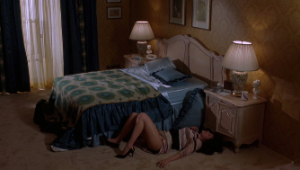
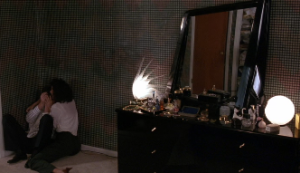
Perhaps my favorite directorial moment in the entire film comes with the slow-motion push in on DeNiro at the bar, puffing that cigarette and eyeing down Morrie with the intention of whacking him, all set to Cream’s “Sunshine of Your Love.” Scorsese loves this technique, giving DeNiro a killer entrance in “Mean Streets” (1973) and giving Sharon Stone the spotlight in “Casino” (1995).
These daring directorial choices reach their zenith during the film’s paranoid Third Act, featuring a barrage of jumpcuts, title cards, superimposed text, gas pedal inserts, rapid zooms during cocaine hits, make-up for drugged-out faces and dynamite soundtrack selection. It’s a triumph not only for Scorsese as director, but for long-time editor Thelma Schoonmaker, who won Oscars for “Raging Bull” (1980), “The Aviator” (2004) and “The Departed” (2006). The Hughes Brothers (“Menace II Society”) described it best, “The whole segment is nothing but cocaine, helicopters and pasta sauce.”
Even in the final minutes, Scorsese is up to something. After an entire film of narrating in voiceover, Liotta rises from the courtroom witness stand to speak to us in direct address. He breaks the “fourth wall” again in the film’s final image, as Pesci shoots a handgun directly at the camera, an homage to “The Great Train Robbery” (1903), showing just how much (and how little) movies can change in 90 years. Scorsese so loved the silent-film homage that he built an entire film around it in “Hugo” (2011), sending a train hurtling toward the screen.
![]()
Soundtrack
What would a Scorsese movie be without a killer rock ‘n roll soundtrack? The “GoodFellas” track listing is not only Scorsese’s personal best, it’s one of the best in movie history. Each song was handpicked by Scorsese, jotting down ideas in the script margins, beginning with a symbolic choice — “Rags to Riches” by Tony Bennett — then moving chronologically through music history.
The golden oldies of the ’50s and ’60s are nothing short of mesmerizing: The Shangri-Lahs, Dean Martin, Jerry Vale, Aretha Franklin, Bobby Darin, The Ronettes, The Drifters, The Cadillacs, Johnny Mathis, The Crystals, Bobby Vinton, The Harptones. It’s just one after the other.
Certain choices play against expectation, making their scenes feel all the more horrific. Note the use of Donovan’s subdued “Atlantis” during the violent beating of Billy Batts.
As we move into the ’70s and ’80s, Scorsese really enters his element with a mix of The Rolling Stones, Cream, Harry Nilsson, The Who, George Harrison and Muddy Waters. In fact, the helicopter sequence was chosen by UnderGroundOnline as the single best use of classic rock in movie history. This Act Three flourish culminates in a Sid Vicious (Sex Pistols) cover of Frank Sinatra’s “My Way,” a fitting sign-off for a director who just made his f’n movie his f’n way.
In the end, the film will leave you humming the piano outro of “Layla” by Derek & The Dominoes, which sets the mood for a mid-movie murder montage, then syncs perfectly the end credits.
![]()
Pop Culture
If you haven’t downloaded the aforementioned songs onto your iPod playlist, what are you waiting for? The soundtrack is just one of the many lasting legacies of Scorsese’s cinema masterpiece. Most immediately, the film inspired DeNiro to make his own directorial debut with “A Bronx Tale” (1993).
The film next inspired the three-piece suits of Jon Favreau and Vince Vaughn in “Swingers” (1996).
Soon after, Favreau guest starred on “The Sopranos,” recruiting Christopher to get the inside scoop on the mafia. As previously mentioned, the Christopher character was played by the same actor who played Spider in “GoodFellas,” just as Bracco went on to play Tony Soprano’s therapist.
“‘Goodfellas’ is the Koran for me,” “Sopranos” creator David Chase told filmmaker/critic Peter Bogdanovich. “I found that movie very funny and brutal and it felt very real. And yet that was the first mob movie that Scorsese ever dealt with a mob crew … as opposed to say ‘The Godfather’ … which there’s something operatic about it, classical, even the clothing and the cars. You know, I always think about ‘GoodFellas’ when they go to their mother’s house that night when they’re eating, you know, when she brings out her painting, that stuff is great. I mean ‘The Sopranos’ learned a lot from that.”
After “The Sopranos” hung it up in 2007, the “GoodFellas” references continued in AMC’s “Breaking Bad” (2008-2013), as Walt and Skyler’s drug evasion echoed Henry and Karen.
On the silver screen, the film inspired Liotta’s casting as Johnny Depp’s father in “Blow” (2001), which felt like an extended version of the Third Act of “GoodFellas,” Rolling Stones and all.
Most recently, director David O. Russell combined his casts from “The Fighter” (Christian Bale, Amy Adams) and “Silver Linings Playbook” (Bradley Cooper, Jennifer Lawrence) for a con-turned-informant tale that brought plenty of comparisons to “GoodFellas,” including a cameo from DeNiro.
![]()
Legacy
With so many pop culture references and a stellar 8.7 IMDB rating, “GoodFellas” is clearly Scorsese’s most popular flick. But is it his best? In 2002, the Sight & Sound global critics poll chose “Raging Bull,” but in 2012, the same poll chose “Taxi Driver.” When the same group polled directors, “Taxi Driver” ranked No. 5 and “Raging Bull” ranked No. 12. “GoodFellas” ranked 48th, thanks in part to David O. Russell and Guillermo Del Toro putting it in their own personal Top 10s.
Here in the U.S., the American Film Institute ranked “GoodFellas” No. 92 in its Top 100 Films, well behind “Taxi Driver” at No. 52 and “Raging Bull” at No. 4. During the broadcast, Steven Spielberg called “Raging Bull” “Marty’s masterpiece,” a claim that’s hard to argue from an artistic standpoint.
But if you were to come up with a rubric that takes into account artistry, popularity, accessibility and influence, “GoodFellas” would clearly top the list for Scorsese. It’s that rare art masterpiece you can pop in for first-time viewers — or film students — without having to give an “ambiguity” disclaimer. There’s something to be said for that. If Scorsese once called movies “the eternal battle between artistic expression and commercial imperative,” “GoodFellas” is the blueprint for walking that line, even if that line is cut in the form of cocaine, pulsating atop a baby grand to Clapton’s eternal piano.


